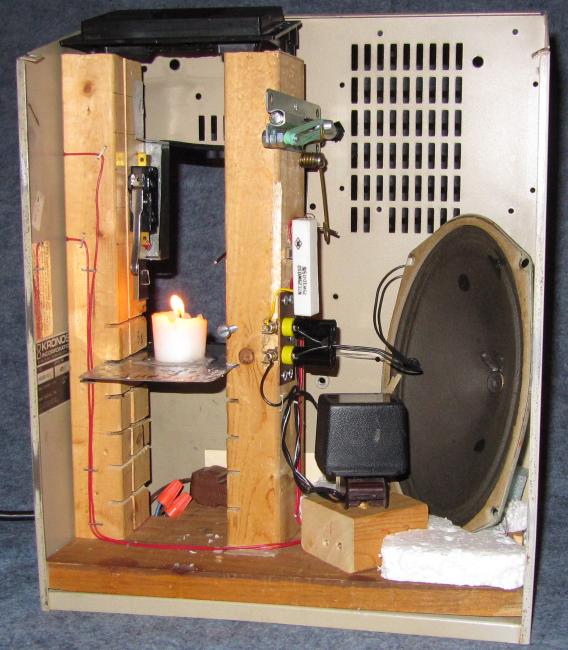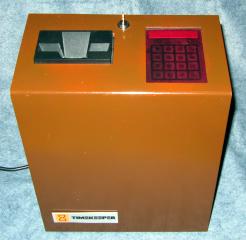|
How did I perform my flaming timecard demonstration?
When I first planned my speech, I considered having the timeclock emit a bright flash, and a huge puff of smoke. I looked into theatrical flashpots to obtain this effect, but quickly rejected the idea. These sorts of effects are hazardous, and generally require training and an explosives license to perform
To build the trick clock, I started off by obtaining an old timeclock case, shown to the left. Actually, I couldn't find a really old brown case, so I had to make do with a more modern bright orange one, which I painted brown. The timeclock started as a case only, with no innards. But I taped an old-style keyboard in the rectangular keyboard opening (top-right), and mounted an injection-molded card throat on the left-hand side, at the right height to protrude through the opening in the cover. The picture below shows the tricked-up clock with the cover removed.

The other labeled parts were to improve the illusion. Recall that I was simulating a situation in which the clock clamped the card, and then refused to release the clamp. Thus I wanted to produce a loud clamping noise, and an audible buzz to represent the frozen-on clamping mechanism. The buzzing noise was initiated by microswitch "M", which was actuated by the timecard sliding down the slot. A transformer "T" provided 12 volts AC, which the microswitch sent to loudspeaker "S", through the 10-ohm resistor "R". This produced a loud 60 Hz buzzing sound as long as the card was inserted.
I used the clock I built for this speech several times in subsequent presentations, and it has never failed to function properly. My two largest audiences were in very large hotel ballrooms, with 800 or more people. I never mentioned to the hotel that I was going to set something on fire, as I thought they probably would have objected. I had some concern about setting off a smoke detector, or, worst case, a sprinkler. But the ballrooms all had very high ceilings, and that was never an issue. I always asked the hotel for a large pitcher of water on the podium, but they took this as a normal request by a speaker. I carefully checked to be sure that the top of the pitcher was wider than the timecard, so that I could put the flames out quickly by dousing the card in the pitcher. For my first speech on the History of Kronos, I carried the clock to Chicago as carry-on luggage, which caused it to be subject to quite a rigorous inspection - hence my comments in the speech about airport security thinking the clock might be an FAA test bomb. But although they found it rather curious, when I opened it up, they were able to see that it had nothing dangerous in it. Because of that difficulty, for a subsequent speech about the year 2000, I shipped the clock to St. Louis well in advance of the speech. I still have the clock, in case I'm ever called upon to repeat the illusion.   |
 Instead, I settled on the simpler idea of setting a timecard on fire. Although I could think of using various electrical ignition devices, I needed my design to set fire to the card with extreme reliability. It wouldn't do to have it fail during the speech. The simple idea I came up with was to simply have a burning candle inside the clock. I surreptitiously lit the candle just before starting the speech.
Instead, I settled on the simpler idea of setting a timecard on fire. Although I could think of using various electrical ignition devices, I needed my design to set fire to the card with extreme reliability. It wouldn't do to have it fail during the speech. The simple idea I came up with was to simply have a burning candle inside the clock. I surreptitiously lit the candle just before starting the speech.
 To the right is the same image, half size, with the parts labeled with red letters. The most important component is the candle "C", which burned until the flaming timecard demonstration. It was positioned such that a timecard inserted into the card throat would come down with its edge just above the flame. Because I could see the candle through a hole in the back of the clock, I could insert the card just the right amount. I would then wait for the card to catch fire before pulling it out to show it to the audience. I discovered that the card would burn more reliably and cleanly if I waxed the cards I used by rubbing them with a candle before using them for the demonstration.
To the right is the same image, half size, with the parts labeled with red letters. The most important component is the candle "C", which burned until the flaming timecard demonstration. It was positioned such that a timecard inserted into the card throat would come down with its edge just above the flame. Because I could see the candle through a hole in the back of the clock, I could insert the card just the right amount. I would then wait for the card to catch fire before pulling it out to show it to the audience. I discovered that the card would burn more reliably and cleanly if I waxed the cards I used by rubbing them with a candle before using them for the demonstration.
 The banging noise of the clamp actuation was provided by the banger mechanism "B", triggered when the lever "L" was depressed by the card. The photo to the left shows the banger in greater detail. It was a simple device made out of a door bolt from a hardware store, bent coat hanger wire, and some rubber bands. Actuation of the lever lifted the small wire loop protruding from the hole in the vertical piece of wood. This released the J-shaped lever in which it rested, allowing it to rotate counter-clockwise around its pivot screw. This in turn released the door bolt, which was then accelerated forward (to the left, in the picture) by the green rubber bands. The tip of the door bolt slammed into the clock's cover, producing a loud bang. This was considerably louder than the usual sound of a normal clock's clamp, and I made a point of leaning forward as I inserted the card, so all the sounds would be picked up by my lavaliere microphone, to add to the startling effect.
The banging noise of the clamp actuation was provided by the banger mechanism "B", triggered when the lever "L" was depressed by the card. The photo to the left shows the banger in greater detail. It was a simple device made out of a door bolt from a hardware store, bent coat hanger wire, and some rubber bands. Actuation of the lever lifted the small wire loop protruding from the hole in the vertical piece of wood. This released the J-shaped lever in which it rested, allowing it to rotate counter-clockwise around its pivot screw. This in turn released the door bolt, which was then accelerated forward (to the left, in the picture) by the green rubber bands. The tip of the door bolt slammed into the clock's cover, producing a loud bang. This was considerably louder than the usual sound of a normal clock's clamp, and I made a point of leaning forward as I inserted the card, so all the sounds would be picked up by my lavaliere microphone, to add to the startling effect.